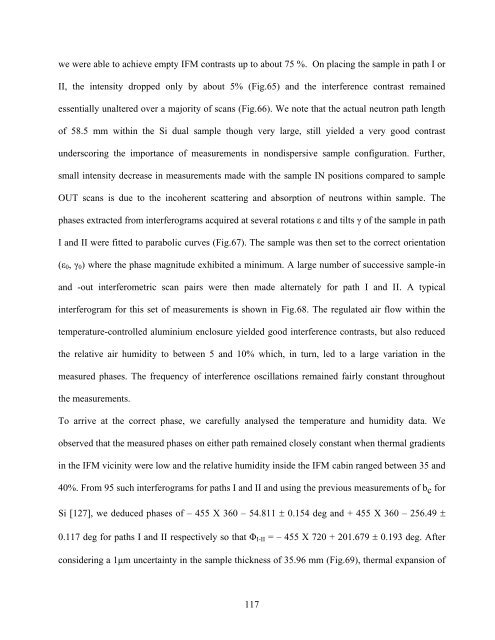PHYS01200804001 Sohrab Abbas - Homi Bhabha National Institute
PHYS01200804001 Sohrab Abbas - Homi Bhabha National Institute
PHYS01200804001 Sohrab Abbas - Homi Bhabha National Institute
You also want an ePaper? Increase the reach of your titles
YUMPU automatically turns print PDFs into web optimized ePapers that Google loves.
we were able to achieve empty IFM contrasts up to about 75 %. On placing the sample in path I or<br />
II, the intensity dropped only by about 5% (Fig.65) and the interference contrast remained<br />
essentially unaltered over a majority of scans (Fig.66). We note that the actual neutron path length<br />
of 58.5 mm within the Si dual sample though very large, still yielded a very good contrast<br />
underscoring the importance of measurements in nondispersive sample configuration. Further,<br />
small intensity decrease in measurements made with the sample IN positions compared to sample<br />
OUT scans is due to the incoherent scattering and absorption of neutrons within sample. The<br />
phases extracted from interferograms acquired at several rotations ε and tilts γ of the sample in path<br />
I and II were fitted to parabolic curves (Fig.67). The sample was then set to the correct orientation<br />
(ε 0 , γ 0 ) where the phase magnitude exhibited a minimum. A large number of successive sample-in<br />
and -out interferometric scan pairs were then made alternately for path I and II. A typical<br />
interferogram for this set of measurements is shown in Fig.68. The regulated air flow within the<br />
temperature-controlled aluminium enclosure yielded good interference contrasts, but also reduced<br />
the relative air humidity to between 5 and 10% which, in turn, led to a large variation in the<br />
measured phases. The frequency of interference oscillations remained fairly constant throughout<br />
the measurements.<br />
To arrive at the correct phase, we carefully analysed the temperature and humidity data. We<br />
observed that the measured phases on either path remained closely constant when thermal gradients<br />
in the IFM vicinity were low and the relative humidity inside the IFM cabin ranged between 35 and<br />
40%. From 95 such interferograms for paths I and II and using the previous measurements of b c for<br />
Si [127], we deduced phases of – 455 X 360 – 54.811 0.154 deg and + 455 X 360 – 256.49 <br />
0.117 deg for paths I and II respectively so that Φ I-II = – 455 X 720 + 201.679 0.193 deg. After<br />
considering a 1μm uncertainty in the sample thickness of 35.96 mm (Fig.69), thermal expansion of<br />
117
















